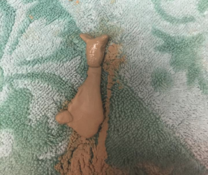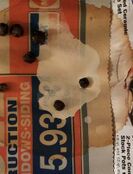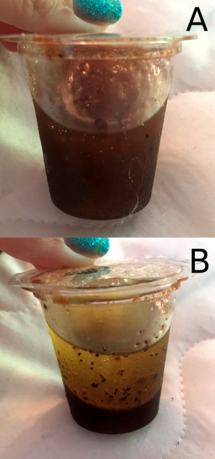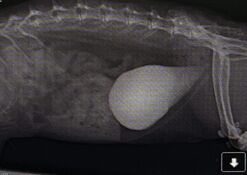Bladder sludge and stones
This article is incomplete because it lacks depth or is unfinished. Help by expanding it.
Bladder sludge, also known as hypercalcinuria or hypercalciuria in rabbits, is a thickening of the urine with calcium salts (usually calcium oxalate and calcium carbonate).[1] Sludgy urine is also called cystitis. These crystals can also condense to form stones, or uroliths, in the bladder, urethra, ureters (duct by which urine passes from the kidney to the bladder), or renal pelvis (tube through which urine flows from the kidney to the urinary bladder).[1] The process of forming stones in the urinary system is called urolithiasis.
Symptoms
Rabbits can remain asymptomatic despite large amounts of sludge in the bladder.[1]


Common symptoms include the following:[1]
- urinating outside the litter box
- thick, pasty, beige- to brown-colored urine; sometimes this urine so thick that it is mistaken for diarrhea.
- extreme urinary frequency (pollakiuria)
- painful or difficult urination (dysuria)
- blood in the urine (hematuria)
- urine staining
- anorexia, weight loss, and lethargy
- tooth grinding and a hunched posture
- constant need to evacuate bowels (tenesmus)
- ataxia, or difficulty moving in rabbits with neurologic or orthopedic disorders leading to urine retention.
Bladder sludge and stones are seen most commonly in middle-aged rabbits 3 to 5 years old and affects all breeds equally.[1]
Sludgy urine has a different appearance than normal urine containing calcium deposits. The sediment in sludgy urine forms a dense solid (precipitate), whereas calcium carbonate deposits in normal urine can easily be shaken up to form a suspension.[2]:410
Causes
"In the past, most of the emphasis concerning the prevention and treatment of bladder sludge and urolithiasis has been placed on the calcium content of the diet. Today, however, more emphasis is placed on water intake, exercise, and preventing obesity. Most instances of the disease can be addressed by improving these three factors." [3]
The reasons for bladder sludge and stones is unclear, but the disease is found more often in obese, sedentary rabbits fed a diet composed primarily of commercial alfalfa-based pellets.[1] Some other common causes of the diseases:[1]
- inadequate water intake (dirty water bowls, unpalatable water, changing water sources, inadequate water provision)
- urine retention (underlying bladder pathology, neuromuscular disease)
- inadequate cleaning of litter box or cage may cause some rabbits to avoid urinating for abnormally long periods.
- obesity
- pain and a reluctance to move
- lack of exercise
- feeding of exclusive commercial pellets
- renal disease
- calcium or vitamin/mineral supplements added to the diet

Registered veterinary nurse Jo Hinde writes:[4]
The most current thinking is that bladder sludge is caused by lack of mobility and not diet.
Ok so the easiest way to describe...think of salad dressing (smile emoticon) if it hasn't been shaken for a week, all the particles drop to the bottom. If it hasn't been shaken for a few months, these particles clump together at the bottom.
Rabbits bladders are the same. Their urine naturally has particles in. As they naturally move around a lot to constantly graze for food, all the particles are well suspended in the pee. If due do obesity, arthritis, disability etc they stop moving around...the particles sink to the bottom of the bladder and no longer mix up and get pee'd out. The longer this happens, the more they clump, turn to sludge and poss stones.
So....in a healthy rabbit, as long as the diet is well balanced, then bladder sludge is actually quite rare.
If they are less mobile, you want to look at the root cause ie lose weight or give pain relief twice daily for arthritis.
You also need to keep very well hydrated. But even then, you don't need to cut out calcium. It's not that simple as it's thought that phosphorous and the ca:pa ratio has more to do with sludge than just calcium intake. Plus there are diff types of calcium and it's vital it's not restricted too much otherwise it affects teeth and bones.
A final point about fresh greens in the diet - only needs to be 1 small handful per day per bunny approx the same size as their head. Yes many rabbits can tolerate more but as always, it's about balance and hay needs to be the main part of the diet. Keep the veg and pellets very low and they eat loads of hay. This also means they drink a lot more rather than getting fluid from the veg thus flushing the kidneys and bladder through more too.
Registered veterinary nurse Jo Hinde (with LagoLearn Ltd) adds:[5]
Let's talk briefly about bladders... Bladder sludge is quite a commonly presented problem. Often a high calcium diet is blamed for this however it is not that simple.
Mobility (or rather the lack of) plays a very important part. Rabbit urine naturally contains a high percentage of large particles. If mobility is reduced due to obesity, arthritis, small enclosure etc then this means the large particles drop to the bottom of the bladder where it is harder for them to be excreted thus forming a sludgy layer.
If the rabbit is frequently active and mobile then these particles are suspended throughout the urine and more easily excreted.
My simple analogy is 'salad dressing'. Look at the difference between the two photos - one has been shaken and the other has not. You can clearly see how the larger particles are suspended in the liquid when the pot is shaken compared to the obvious separation when it is kept still.
So in short, when presented with a bladder sludge case be sure to investigate all the possible causes for reduced mobility and don't just get hung up on the diet. Learn more rabbit specific tips at one of our training events. LagoLearn Ltd
Treatment
Mary E. Cotter, founder of Rabbit Rescue & Rehab, writes on the subject:
When rabbits have bladder sludge, there's a lot of controversy on how to deal with that. It's poorly understood. The phenomenon is poorly understood. People used to think that if you took calcium out of the diet or removed as much as possible, fed the rabbit no high-calcium vegetables, that that would help. But what we found out through the years is that this really is a metabolic problem. Changing the diet may not be a good thing, and, in fact, may be a bad thing because if the rabbit's diet has less calcium, the rabbit may start drawing calcium from his bones to meet his calcium needs. He may start excreting the same amount of calcium.
- The Rabbit House. Low Calcium Diet for Rabbits
Experiences
- Bernadette Ramirez. (2021). Alphie's large bladder stone (Graphic)
- Dr. Lauren Thielen. (2021). Largest bladder stones the vet had ever seen (Graphic)
- The Unusual Pet Vets. (2021). Lulu's story with bladder sludge (Graphic)
- Leslie Chavers. (2021). RubyBelle's story with a bladder stone lodged in her urethra that was eventually passed on her own. (Graphic)
- Rabbitats. (2019). Munch's x-ray with bladder and urethra stones and a herniated bladder
- Avian and Exotic Clinic of Monterey. (2015). Stella's jax-shaped bladder stone (Graphic)
Further reading
- Dr. Kanfer. (2023). Kanfer’s Answers: Bladder Sludge and Stones
- Claire Speight, Veterinary Nurse, MBVNA. Urolithiasis
- Cayla Iske, PhD, & Dianne Cook, Licensed Veterinary Technician. (2019) Bladder Sludge in Rabbits and Guinea Pigs
- Barbara L. Oglesbee. (2011). Hypercalciuria in Rabbits [PDF]
- Dan Johnson, DVM, DABVP. (2009). Rabbit calcium metabolism, "bladder sludge," and urolithiasis (Proceedings)
- Victoria A. Papscoe, DVM. (2009). Bladder Sludge in Rabbits
- Susan Brown, DVM. (2006). Bladder Stones and Bladder Sludge in Rabbits
- Dana Krempels, Ph.D. Urine Scald: A Symptom of a Greater Problem (search for 'Bladder sludge' and 'Bladder stone (urolith)')
- Sue A. Kestenman, DVM. (1995). Bladder Disease and Bladder Stones in the Rabbit
- MediRabbit. Normal urine and “sludge” in rabbits (Graphic)
- Esther van Praag, Ph.D. Nephroliths and uroliths (calculi) in rabbits (Graphic)
See also
References
- ↑ 1.0 1.1 1.2 1.3 1.4 1.5 1.6 Oglesbee, B. (2011). Blackwell's five-minute veterinary consult: Small mammal. (2nd ed.).
- ↑ Varga, M. (2013). Textbook of rabbit medicine. (2nd ed.).
- ↑ Dan Johnson, DVM, DABVP (2009). Retrieved 1st March, 2017, from http://veterinarycalendar.dvm360.com/rabbit-calcium-metabolism-bladder-sludge-and-urolithiasis-proceedings?id=&sk=&date=&pageID=6
- ↑ Hinde, J. (2016). In Facebook [Group page]. Retrieved 15 March, 2016, from https://www.facebook.com/groups/houserabbit/permalink/10153917739868809/?comment_id=10153918391128809&comment_tracking={%22tn%22%3A%22R1%22}
- ↑ Hinde, J. (2017). In Facebook [Group page]. Retrieved 31 March, 2017, from https://www.facebook.com/lagolearn/posts/1704012859896505


